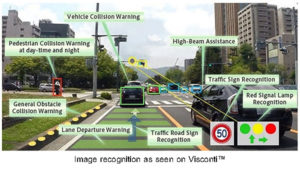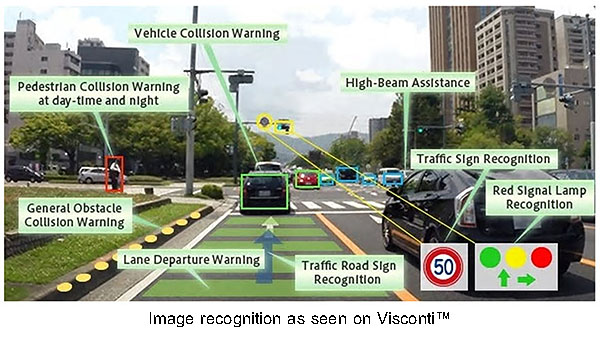
Here at Toshiba, we offer two in-house awards named after our founding fathers, Hisashige Tanaka and Ichisuke Fujioka. Tanaka, born in 1799, was nicknamed “Karakuri Giemon”, the genius of mechanical wonders. A genius inventor, he created an “unopenable” inkstone box (with a secret lock) at the age of 9, and later invented the “Myriad Year Clock,” an ornate and incredibly complex universal clock designed to work for tens of thousands of years.
The Hisashige Tanaka Award, named after this iconic individual, is usually awarded to only one person. This year, it was awarded to two engineers under the same development banner.
Image recognition processor created by the teamwork of basic research and product development
Demand for self-driving cars and the safety it brings with it is rising, particularly in Japan, where a super-aging society has upped the stakes considerably in recent years. This is where the winner of this year’s Hisashige Tanaka Award, Visconti™ comes in. Self-driving systems require high-level image recognition to see and understand its surroundings followed by decision making, so that humans don’t have to. The latest version of Visconti™ 5 contributes to all these functions while also achieving lower power consumption than our conventional processors.
There are roughly two technologies that make up Visconti™.The first is image recognition. This is the technology tasked with recognizing/detecting the other cars, pedestrians, and traffic lights from images on the vehicle-mounted cameras, and then assisting in taking action to prevent or avoid collisions, whether it be day or night. Toshiba has conducted basic research in image recognition technology for over half a century. When they first began the research, AI and self-driving cars were an impossible dream. And yet so many of Toshiba’s past engineers had believed in the potential of image recognition technology and had worked tirelessly to refine it, eventually developing it into what it is today.
“Visconti™ is the fruit of all the efforts of the engineers that came before us at Toshiba. Even now, many engineers are involved in the research and development process. I believe we won this award as representatives of this entire group of people.”
So says Ryuzo Okada, winner of the Hisashige Tanaka Award and Senior Manager of the Media AI Laboratory at the Corporate Research and Development Center.
“But no matter how good an image recognition technology is, it can’t hold up a business on its own. It only becomes viable as a business, a product, when you ‘embody’ it as a processor,” said Okada.
The person in charge of this embodiment process was Takashi Miyamori, General Manager of the Electronic Devices & Storage Research & Development Center at the Toshiba Electronic Devices & Storage Corporation, the other winner of the award. And it is this embodiment that is, in fact, the other half of the technology that makes up Visconti™.
“Nothing would happen if you don’t have any good idea in your basic research in the first place. And even if you are able to come up with an idea, it still wouldn’t be viable business-wise unless you’re able to turn it into a proper product. And so I do think it’s very meaningful that we both won this award at the same time,” said Miyamori.
The research & development division, with its basic research. The research & development division on the business side, working to turn the technology into a viable product. Without their teamwork, Visconti™ may never have been born.
A call that saved the project
In self-driving cars, what once seemed a far-off dream is quickly becoming reality. Indeed, Visconti™ is able to become the product it is because of the immense expectations placed in recent years on self-driving systems in general. Things were not always smooth sailing, however—take 2008, during early development. The first generation of Visconti™ had not achieved good enough sales to prove itself viable as a business, and the Visconti™ development team had been disbanded as a result.
Looking back, Okada says, “The research team at Corporate R&D Center was disbanded as well, and the future of research into image recognition technology for automotive application seemed very precarious.”
That is, until a call came in from an automobile parts manufacturer. This was right around the time the media had begun picking up stories about cars with automatic emergency braking, discussing how the radars and cameras mounted on the cars could “watch” the car driving ahead and activate the brakes automatically if needed, preventing or limiting the damage from collisions. This increase in demand had piqued the manufacturer’s interest in Visconti™.
“If that call hadn’t come in it when it did, that would have been the end of Visconti™,” said Okada.
With this, the company decided to reevaluate the potential value of Visconti™. And finally, the management gave the OK to continue development on the product.
The development process, however, was marked by difficulty after difficulty. The development of automobiles is intimately intertwined with concepts of safety and security—and as such, the level of technology required by customers had been much higher than they had initially expected. Not to mention the very high expectations placed on them in terms of reducing power consumption as well.
“It wasn’t easy, with our limited resources at the time, to create a high-performance system that also required low power consumption. We had discussion after discussion with Okada’s team, all of us working as hard as we could to develop a product that was at the level our customers wanted,” said Miyamori.
Visconti™ was not simply a brainchild of Toshiba engineers. It was created with the customers, with their input. Indeed, it is only when customer needs are incorporated into original Toshiba technologies that the technology becomes product.
“What we learned from developing Visconti™ was that it’s not enough to wait for the customers to tell you what they want. It’s important to think about the features and functions that customers will want in the future, and prepare solutions for these needs in advance. Doing so makes it possible for us to create products with features that reflect Toshiba’s strengths. This ability to propose ideas is what’s necessary to keep a business going,” said Okada.
With Visconti™, the future of image recognition technology looks promising for Toshiba. What lies in front of them now is a myriad of possibilities. Both award-winners, however, say that they never could have predicted their current success when they first began their journeys at Toshiba.
It was more than 30 years ago that Miyamori began working for Toshiba. Development on large-scale integrated circuits (LSIs) had only just begun, and he had been placed in a division that was about three years old, staffed mostly with new employees. Understandably, there was no structured training system and work in the division was mostly done through trial and error.
“It was hard, yes, but at the same time we were given a lot of freedom to try what we wanted. The division was full of people saying, ‘Let’s do this!’ ‘I’d want something like this!’ I think Visconti™ exists as it is today because the project was led by people with this kind of passion for their work,” said Miyamori.
Okada had had a similar experience as well. When he first began working for Toshiba, he had been assigned to a research center in the Kansai area (Western Japan). This research center, much like Miyamori’s, had had a relaxed atmosphere where his superiors—all strong, unique personalities—were free to devote themselves to the research they were interested in.
“While we did our work, we were unsure of the success of our research. I think the most important thing when working tenaciously in this atmosphere is to do what you think is fun. Even if it’s something that someone requests of you, you can find something in there that you think is interesting. This is the kind of mentality that I’d want the younger employees to have,” said Okada.
Two engineers—one from the basic research side, the other from the business side—are united in their passion for “look for a better way”. What will the future look like? What kind of things will happen, and what kind of things will people want? Their shared vision of the future unites them across division and company lines, and allows them to create something together. With Visconti™, Toshiba aims to make the world a better place. And their journey has only just begun.
Visconti™ is a trademark of Toshiba Electronic Devices & Storage Corporation.




